As we discussed in the last Hyper-V for beginners article, we looked at how to install Microsoft Hyper-V in Windows Server Core for beginners. In this post, we will take a look at how to manage a Windows Server Core installation running the Hyper-V Role. As we learned, the Windows Server Core installation option installs a GUI-less version of Microsoft Windows Server that drastically reduces the attack surface and provides a smaller footprint with many advantages. Next, let’s look at remotely managing Hyper-V on Windows Server Core.
Table of Contents
- Why remote Hyper-V management is important
- Remote Desktop (RDP)
- Hyper-V Manager
- PowerShell remoting
- Wrapping Up
Quick Bites:
- Remote management of Hyper-V servers is crucial, especially for Windows Server Core installations without GUI.
- Remote Desktop (RDP) enables accessing and managing Windows Server Core installations remotely.
- Hyper-V Manager serves as the primary tool for managing Hyper-V hosts, allowing creation and management of virtual machines.
- PowerShell Remoting facilitates running PowerShell commands on remote servers, enhancing remote management capabilities.
- Understanding remote management is essential for Hyper-V beginners, whether using Windows Server Desktop Experience or Core installations.
Why remote Hyper-V management is important
You may wonder why you need to manage your Hyper-V server remotely. There are two types of remote management when it comes to Hyper-V. First, you can remotely manage the Windows Server Core installation with the Hyper-V Role installed (Windows itself), and then you can manage the Hyper-V Role and Hyper-V specific actions, configuration, and management. It includes creating, configuring, and managing virtual machines.
Remote Desktop (RDP)
As we know, Windows Server Core does not have a GUI, making it more challenging to manage from the console. However, sometimes we need to remote into the Windows Server Core server and run commands or use SConfig. We can enable Remote Desktop to have a way to remote into our Server Core installation of Windows Server.
By default, Remote Desktop is disabled on Windows Server Core installations of Windows Server. However, you can view the current Remote Desktop settings using SConfig. As you can see below, option 7 controls the Remote Desktop enablement.
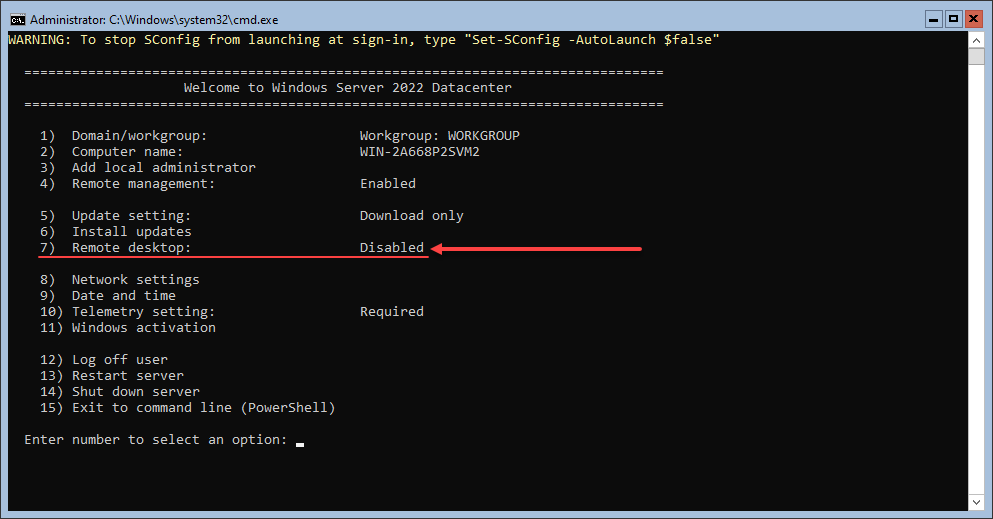
After entering option 7, you can type “E” to enable Remote Desktop on the Server Core installation.
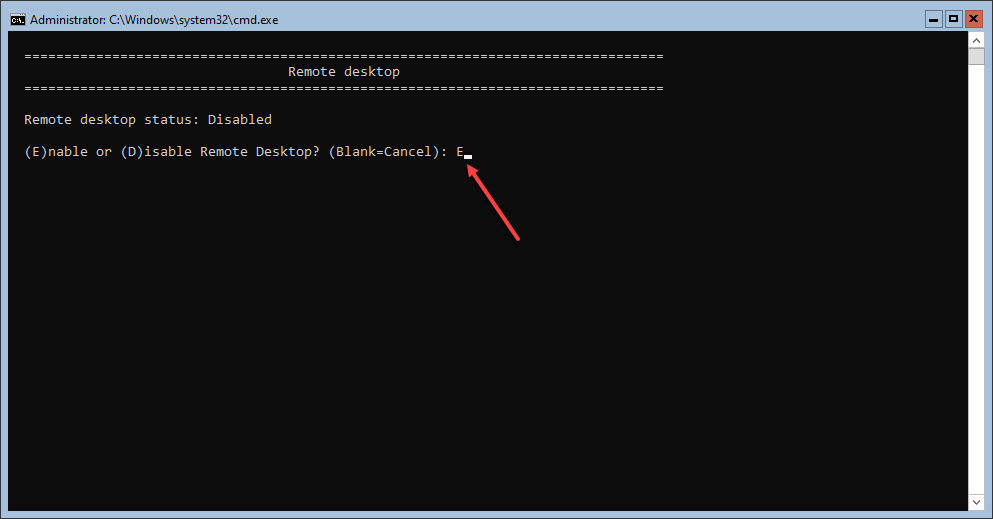
Choose the Remote Desktop security model.
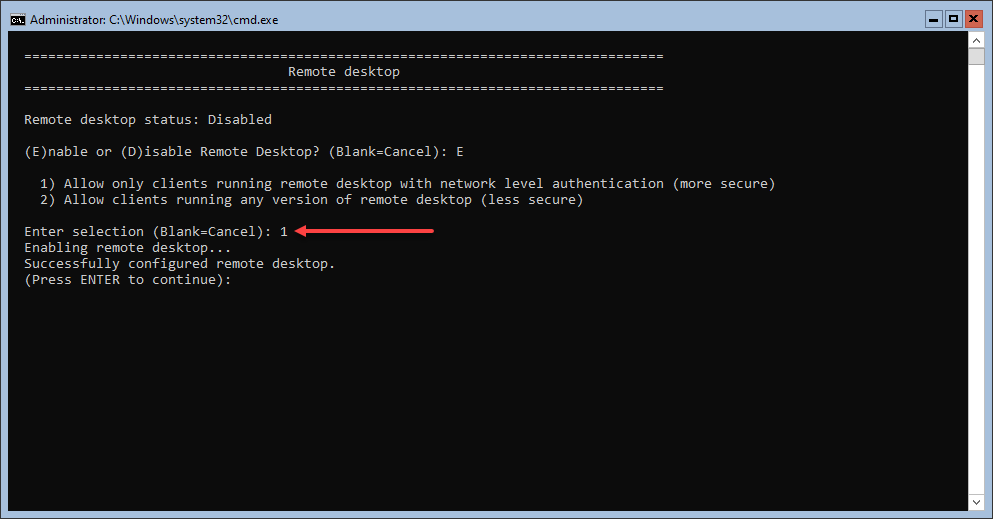
Hyper-V Manager
From a Hyper-V standpoint, the de facto management tool for managing Hyper-V is the Hyper-V Manager console. It is an MMC console that easily manages your Hyper-V host, creates virtual machines, manages Hyper-V networking, etc. But, again, without the Windows Desktop experience installed, we need to remotely connect Hyper-V Manager to the Windows Server Core installation running Hyper-V. It is a built-in function found in the Hyper-V Manager utility. It allows connecting to local and remote Hyper-V hosts.
If you already have a Windows Server with the Desktop Experience installed, you can install Hyper-V Manager as part of the Remote Server Administration Tools (RSAT). If you have another Windows Server running the Hyper-V Role, you will have Hyper-V Manager installed. You can also install Hyper-V Manager on any Windows Server, using the PowerShell cmdlet:
- add-windowsfeature rsat-hyper-v-tools
There is a consideration about which versions of Hyper-V manager are used with which Hyper-V host version. Note the following table from Microsoft that documents which versions of Hyper-V Manager are compatible with which Hyper-V host version.
| Hyper-V Manager version | Hyper-V host version |
|---|---|
| Windows Server 2016, Windows 10 | – Windows Server 2016—all editions and installation options, including Nano Server, and corresponding version of Hyper-V Server – Windows Server 2012 R2—all editions and installation options, and corresponding version of Hyper-V Server – Windows Server 2012—all editions and installation options, and corresponding version of Hyper-V Server – Windows 10 – Windows 8.1 |
| Windows Server 2012 R2, Windows 8.1 | – Windows Server 2012 R2—all editions and installation options, and corresponding version of Hyper-V Server – Windows Server 2012—all editions and installation options, and corresponding version of Hyper-V Server – Windows 8.1 |
| Windows Server 2012 | – Windows Server 2012—all editions and installation options, and corresponding version of Hyper-V Server |
| Windows Server 2008 R2 Service Pack 1, Windows 7 Service Pack 1 | – Windows Server 2008 R2—all editions and installation options, and corresponding version of Hyper-V Server |
| Windows Server 2008, Windows Vista Service Pack 2 | – Windows Server 2008—all editions and installation options, and corresponding version of Hyper-V Server |
The Hyper-V Manager is installed as part of the Remote Administration Tools installed with the Hyper-V role. The dialog box asking about installing additional features includes Hyper-V Manager and the Hyper-V PowerShell module.
You can launch the Hyper-V Manager console using the command virtmgmt.msc. After launching the Hyper-V Manager, right-click on the Hyper-V Manager node in the console. Select Connect to Server
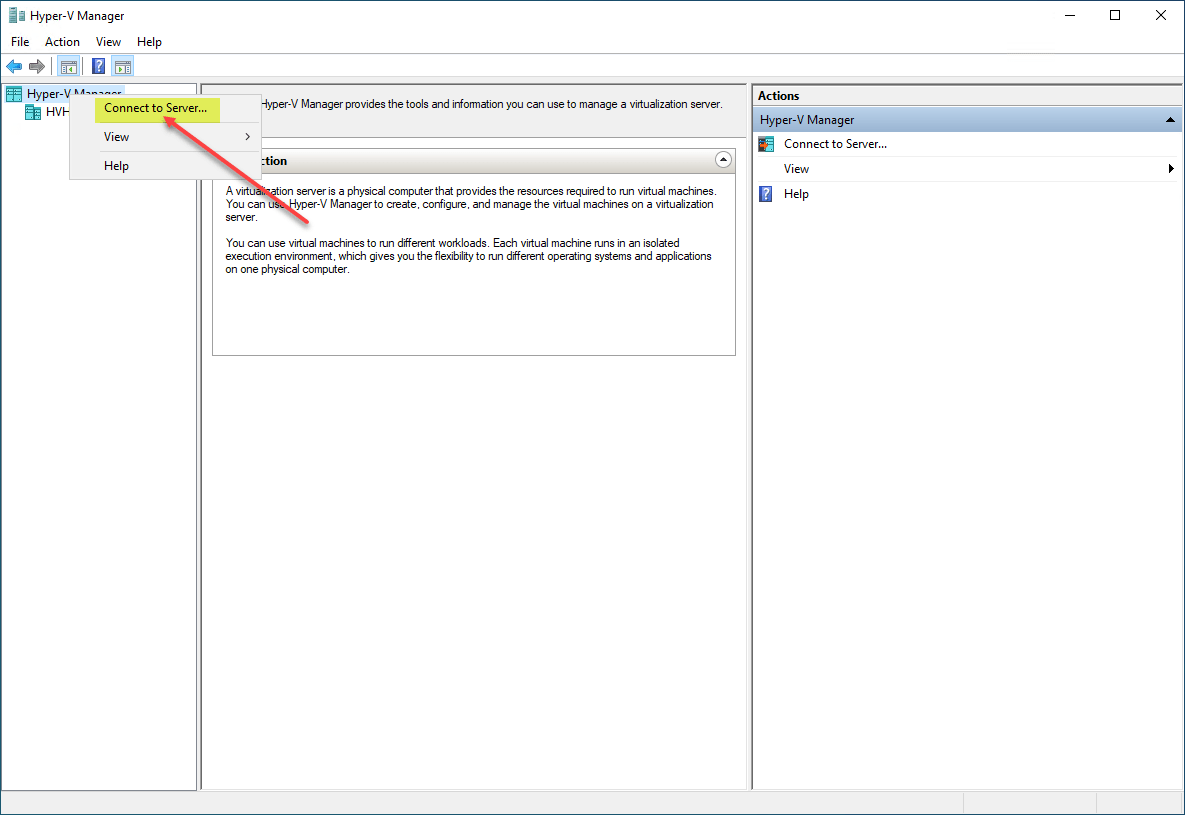
Enter the name of the Hyper-V server to which you want to connect. Here you would enter the name of the remote Windows Server Core installation running the Hyper-V role. If you click browse, you can also browse the directory to select a Hyper-V Server as part of the domain.
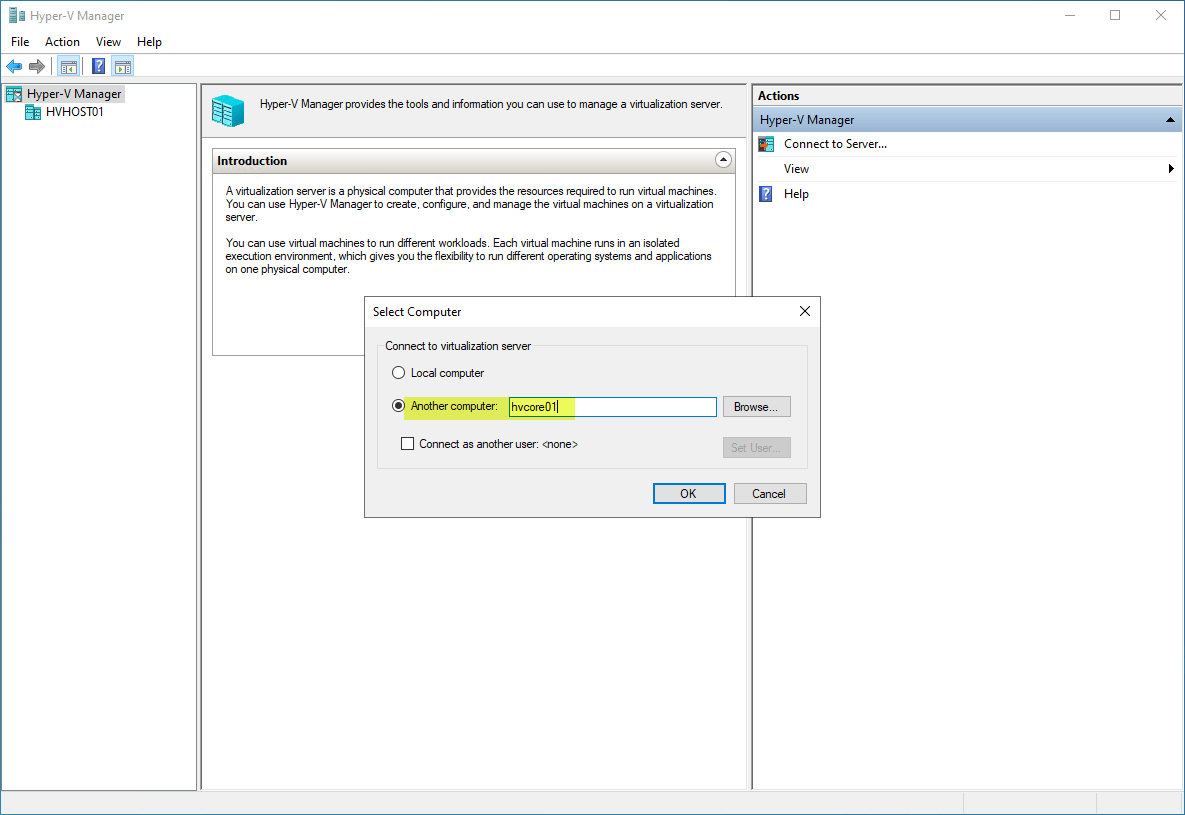
Below, I have connected to the remote Windows Server Core server running Hyper-V. As you can see below, once you have connected to the remote Hyper-V server, you can manage and configure the Hyper-V server and virtual machines as you would be able to if connected to a local Hyper-V server.

PowerShell remoting
There is another type of remote management you can enable called PowerShell Remoting. PowerShell Remoting allows you to connect to a remote Windows Server and run PowerShell commands on that server as if you are logged into the console. You can enable PowerShell Remoting using the SConfig utility.
Alternatively, you can use the cmdlet:
- Enable-PSRemoting
To manage remote Hyper-V hosts, enable remote management on both the local computer and remote host.
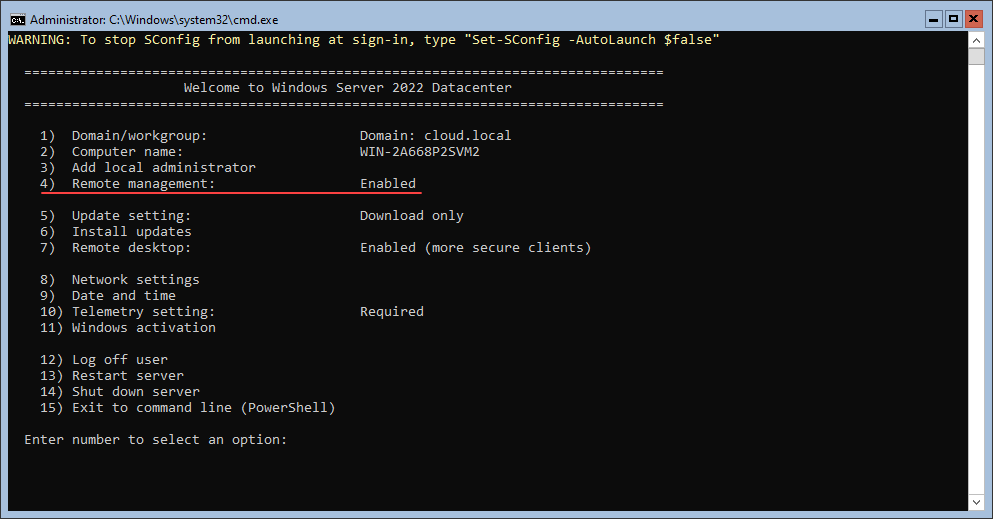
It is important to note that with Windows 8.1 and earlier, remote management only works when the hosts are in the same domain, and your local user account is also on the remote host.
Wrapping Up
Remotely managing your Hyper-V hosts is a crucial part of Hyper-V administration, especially when Hyper-V runs on a Windows Server Core installation without the GUI. Hyper-V management. When considering learning Hyper-V for beginners, it is essential to understand the fundamental concepts of remote management, both with Windows Server Desktop Experience with the Hyper-V Role and Windows Server Core installations. In the next post, we will take a look at Windows Admin Center, the new Windows Server Management solution from Microsoft. We will see what features and capabilities are included for Windows Server and Hyper-V management.
Check out the other articles in this Hyper-V Beginner’s series:
Beginners’ Guide for Microsoft Hyper-V: Overview of Hyper-V (Part 1)
Beginners’ Guide for Microsoft Hyper-V: How to Install Microsoft Hyper-V Using Server Manager -(Part 2)
Beginners’ Guide for Microsoft Hyper-V: How to Install Microsoft Hyper-V with PowerShell -(Part 3)
Beginners Guide for Microsoft Hyper-V: How to Install Microsoft Hyper-V in Windows Server Core – Part 4
Hyper-V Mastery: A Step-by-Step Guide for Beginners to Elevate Your IT Skills and Boost Your Career
Follow our Twitter and Facebook feeds for new releases, updates, insightful posts and more.



Leave A Comment